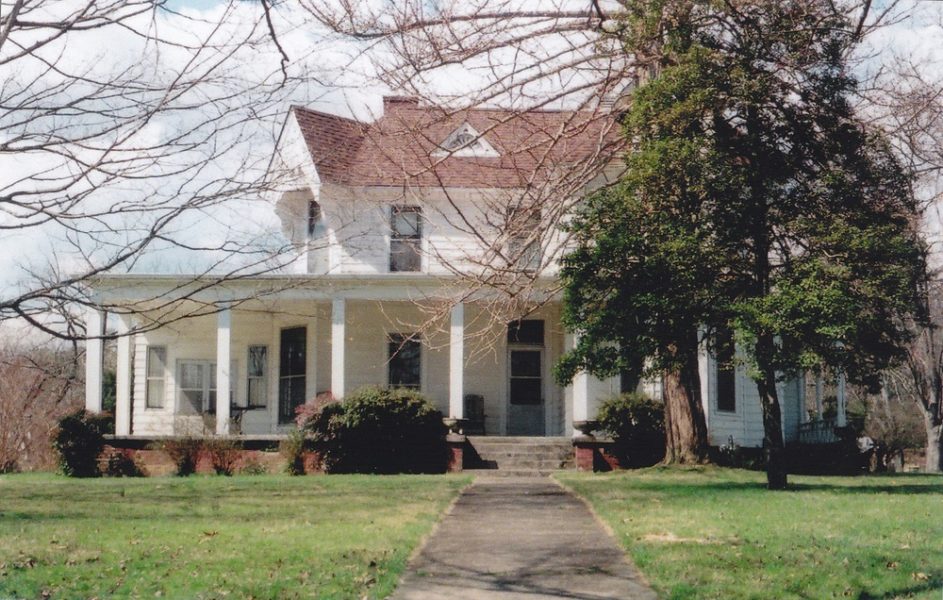Richard Cardwell Jackson (1809-1892) was born in Knoxville on Sept. 27, 1809, one of the sons of Capt. Joseph Jackson. He married Miss Julia Brazleton, a daughter of Gen. and Mrs. William Brazleton of New Market in November 1845. They lived in Knoxville until 1849, when he removed to Athens where he engaged in mercantile business until 1852. In that year he became general manager and superintendent of the East Tennessee and Georgia Railroad, which position he held until about 1875.
In the 1850s, transportation improvements were vital if East Tennessee’s industrial development was to keep pace with the rest of the nation. Two separate railroad companies, the East Tennessee and Virginia and the East Tennessee and Georgia, began to expand and to connect Knoxville with existing railroads in Virginia and Georgia.

Major Richard C. Jackson (Photograph courtesy of the McClung Historical Collection)
The ET&G began its operations from Knoxville in 1855 and the following year trains were operating out of Knoxville on the ET&V. By 1858, the entire line from Dalton, Georgia, to Bristol, Tenn.-Va., was operating.
The Civil War years (1861-1865) saw portions of the system changing hands as first the Southern armies and later the Union armies seized cities along the route. After the war, state aid enabled the two railroads to resume profitable operations and to again consider consolidation.
This was formally consummated on Nov. 26, 1869, and, between 1872 and 1885, a dramatic expansion resulted in the building of 2,500 miles of railroads in five states. Several acquisitions directly affected Knoxville and its economy.
Obviously, such an expansion took formidable managerial leadership. Charles McGhee provided that leadership.
Charles McClung McGhee (1828-1907) was born on his father’s 15,000-acre plantation in the Valley of the Little Tennessee River. He married Isabella White, the great-granddaughter of James White, Knoxville’s founder. He moved to Knoxville about 1860 to explore his own business opportunities and to manage his wife’s valuable real estate here. But the railroads were the real source of his fortune and also a key to the prosperity of Knoxville.
Among his associates in expanding the rail system were John R. Branner, Thomas H. Callaway, R.C. Jackson, Joseph Jaques and Richard T. Wilson. McGhee formed a syndicate which combined the majority of the stock of the two railroads into one company – the East Tennessee, Virginia and Georgia Railroad with headquarters in Knoxville. They allied themselves with northern capitalists and gained control of the Memphis and Charleston Railroad which connected with the ETV&G in Chattanooga. Thus, Knoxville became the headquarters of an important railroad system.
McGhee was the financial genius who made the vast expansion possible with his local connections and his ability to promote Northern investment. But, day to day operation of the railroads was essential too and that took people like Major R.C. Jackson.
In 1852, Jackson became general manager and superintendent of the East Tennessee and Georgia railroad, which position he held until about 1875. He had several other business ventures. He was a member of the board of directors of the Knoxville Gas Light Co. which achieved its first contract with the city in 1855. In 1867, he was one of the organizers of the East Tennessee Iron and Coal Co., which eventually became the East Tennessee Coal Co. with 50,000 acres of land along a 13-mile stretch of the Knoxville and Ohio Railroad. At the time this was the finest and most accessible coal in any part of the state.
In January 1872, Jackson helped organize the Republic Life Insurance Co. of East Tennessee and was elected its first president. He helped organize the East Tennessee National Bank in July 1872, became its first president and was long identified as an official, remaining a director until his death.
His wife died in 1880 and five years later he built and removed to the place where he died, his stately mansion at 4003 Tazewell Pike. The prestigious architectural firm of Stephenson and Getaz oversaw the construction with features like spectacular interior woodwork, six carved fireplaces with elegant mantles, a nine-foot-tall parlor “pocket” door that is approximately 20 feet wide, and four large porches, which, it was discovered, were built without nails.
Major Jackson was 82 years and had suffered poor health all winter, but had been much better for four months. However, his son George discovered him in distress on the morning of June 19, 1892, and came to his aid. Before his physician could be called, the Major had succumbed.
Six of his seven children survived him: Mrs. Reece Arnwine, of near Athens; W.B. Jackson, Mrs. Wallace Rogers, Mrs. W.A. Harrison and George Jackson, of Knoxville, and James Jackson of Texas. He was a member of the Meridian Sun Lodge, A.F.A.M., of Athens, and Pearl Chapter Royal Arch Masons, of Knoxville.
The funeral services were held at his residence with the Rev. Dr. George Caldwell of Bristol and the Rev. Dr. James Park of Knoxville conducting. He was buried by the side of his wife in Cedar Grove Cemetery, near Athens. A special train carried mourners to Athens for the services. His pallbearers were some of the most influential local businessmen: F.H. McClung, D.A. Carpenter, C.E. Lucky, John S. VanGilder, J.Y. Johnson, W.W. Woodruff and B.R. Strong.
(Author’s Note: The author wishes to express his appreciation to Jamie Rowe and Gladys Dial Kirchner for assistance with this essay.)
Jim Tumblin, retired optometrist and active historian, writes a monthly series called “Fountain City: Places That Made a Difference” for KnoxTNToday.com.

